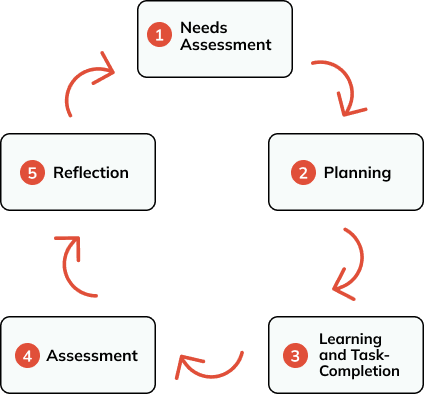Planning Instruction: the PBLA Framework
In LINC, the instructional planning cycle described below guides planning, teaching, learning and assessment. It is grounded in the principles of the CLB and PBLA. It includes five key stages, and involves both the instructor and learners.

| Instruction Cycle Stage | The Instructor | The Learner |
|---|---|---|
Instruction Cycle Stage
Needs Assessment
|
The Instructor
conducts needs assessment
|
The Learner
participates in needs assessment
|
Instruction Cycle Stage
Planning
|
The Instructor
plans the module including real-world tasks and skill-building activities
|
The Learner
|
Instruction Cycle Stage
Learning and Task-Completion
|
The Instructor
teaches skills and guides learners through task-completion, while reflecting on their own teaching and it’s
effect on learners
|
The Learner
completes skill-building activities and real-world tasks, and provides feedback on their learning
|
Instruction Cycle Stage
Assessment
|
The Instructor
assesses for learning and provides action-oriented feedback
|
The Learner
conducts
self-assessment
or peer-assessment
|
Instruction Cycle Stage
Reflection
|
The Instructor
reflects on feedback
for further planning
|
The Learner
reflects on feedback
for further planning
|
While the chart above presents instructional planning as a linear process, it is important to remember that the stages don’t always follow this order. Many are ongoing processes. For example, an informal needs assessments could happen in the middle of instruction to ensure the learners’ needs are still being met, or formative assessment could be happening anywhere along the continuum to assess learners’ progress. While instruction should always be thoughtfully planned, it is also an organic process that involves reflection and adaptation along the way.
Stage 1 – Needs Assessment: the instructor conducts a needs assessment to identify how learners need to use English in their community, education or workplace. The purpose is to either to identify themes that are important to learners or identify particular areas of focus or tasks within a theme. Needs assessments can take many forms and can include discussions, brainstorms, surveys, checklists, pictures and or interviews.
Stage 2 – Planning: following the needs assessment, instructional planning takes shape, incorporating a backward design. Begin by identifying real-world tasks and analyze them to identify specific skills and language items learners need to know to perform the tasks. These skills and language items may include grammar, pronunciation, vocabulary, expressions, background knowledge, sociolinguistic knowledge, sociocultural norms and learning strategies. These can form the basis of some of the skill-building activities.
Stage 3 – Learning and Task Completion: the next stage involves the completion of skill-building activities and real-world tasks. In a learner-centred class, whether online or in-person, the instructor takes on the role of guide, working together with learners and supporting them through the learning process. In this stage, the instructor is observing learners, eliciting their feedback, determining whether instruction and learning activities are effective, and continually making instructional adjustments to meet the needs of learners. Learning happens through skill-building activities which practice all the elements identified as needed for successful completion of the real-world task identified at the beginning of the theme. These include vocabulary and grammar exercises, pronunciation practice or controlled, supported dialogue practice. Once there is confidence, on both sides, that learners are demonstrating competence with the activities practiced, assessment can be planned. This is an opportunity to be learner-centred and include assessment criteria that learners were engaged with demonstrated proficiency in.
Stage 4 – Assessment: this can include learner self-assessment, peer-assessment, informal assessment for learning of skill-using tasks or the assessment of a task at the end of a module. The latter two can all be used as artefacts in the learner’s portfolio. When you assess learners, provide action-oriented feedback that informs them about what they have done well, and gives them specific direction for what they can do to improve.
Stage 5 – Reflection: after the assessment, learners can reflect on the feedback for further learning. They can evaluate their performance in recent work and overall progress, and should be able to recognize areas they need to work on to move forward. Instructors reflect on how learners did, where they were successful and where they needed more practice or support, and use this information for further planning. Then the cycle repeats itself.
EAL Literacy Learners
The instructional planning cycle is similar when you are working with EAL literacy learners as long as each step of the process is at an appropriate language and EAL literacy level. For example, needs assessment tools can be oral or pictorial. You will also need to identify learners’ EAL literacy and numeracy skill gaps in order to address them in instruction. The Continuum of Literacy Skills in CLB: ESL for ALL provides a continuum of the development of EAL literacy skills and A Practical Guide to Teaching ESL Literacy goes into the development of EAL literacy skills in detail.
Helpful Hint
You would benefit from familiarity with previous sections under the “Instructional Practices” Essential Component.
Useful Resources and References
Related Essential Components
- Canadian Language Benchmarks (CLB)
- Portfolio Based Language Assessment (PBLA)
- Needs Assessment
- Planning Instruction: the PBLA Framework
- Real-World Tasks (RWTs)
- Skill-Building Activities
- Learner Reflections
- Assessment Tasks
- Action-Oriented Feedback
- Self-Assessment
- Peer-Assessment
- Themes
- Task Analysis
- Learner-Centred Approach
- Module Planning
- EAL Literacy Learners
External Links
- PBLA Practice Guidelines
- Feedback opportunities throughout the term: PBLA Feedback Opportunities
- Instructor Tools for PBLA
- CLB Support Kit
- The continuum of literacy skills: CLB: ESL for ALL
- CLB: ESL for ALL Support Kit
- Development of literacy skills: A Practical Guide to Teaching ESL Literacy
- CCLB Multi-Level Modules
External Courses
• PBLA Training Courses for instructors working in LINC programs
References
• Willis, D. & Willis, J. (2007). Doing task-based teaching. Oxford University Press.


